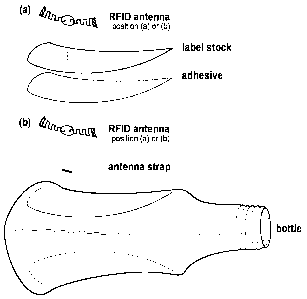Some of the information on this Web page has been provided by external sources. The Government of Canada is not responsible for the accuracy, reliability or currency of the information supplied by external sources. Users wishing to rely upon this information should consult directly with the source of the information. Content provided by external sources is not subject to official languages, privacy and accessibility requirements.
Any discrepancies in the text and image of the Claims and Abstract are due to differing posting times. Text of the Claims and Abstract are posted:
| (12) Patent Application: | (11) CA 2540953 |
|---|---|
| (54) English Title: | RFID ITEM LEVEL LABEL CONSTRUCTION WITHOUT NEED FOR CHIP OR STRAP ATTACHMENT |
| (54) French Title: | FABRICATION D'ETIQUETTE DE NIVEAU D'ARTICLE A IDENTIFICATION PAR RADIOFREQUENCE SANS PUCE NI ATTACHE A BARRETTE |
| Status: | Deemed Abandoned and Beyond the Period of Reinstatement - Pending Response to Notice of Disregarded Communication |
| (51) International Patent Classification (IPC): |
|
|---|---|
| (72) Inventors : |
|
| (73) Owners : |
|
| (71) Applicants : |
|
| (74) Agent: | MACRAE & CO. |
| (74) Associate agent: | |
| (45) Issued: | |
| (22) Filed Date: | 2006-03-27 |
| (41) Open to Public Inspection: | 2007-09-27 |
| Availability of licence: | N/A |
| Dedicated to the Public: | N/A |
| (25) Language of filing: | English |
| Patent Cooperation Treaty (PCT): | No |
|---|
| (30) Application Priority Data: | None |
|---|
An RFID item level construct involves an antenna printed or otherwise placed
upon or integrated
into a label or wrapper; an RFID strap placed directly upon the surface of an
item level container, such as
a bottle, case, box, or container of any irregular, regular, round, square or
other shape made of any non-
metallic material, or if made of metallic material placed using a spacer (such
as foam or cardboard); and
an indirect matching of the two components by placing the pre-printed label
upon the container in
exactly the usual fashion without regard to any special attachment process,
material, connecting or other
handling requirement in order to make a fully functioning RFID-enabled item.
Note: Claims are shown in the official language in which they were submitted.
Note: Descriptions are shown in the official language in which they were submitted.

2024-08-01:As part of the Next Generation Patents (NGP) transition, the Canadian Patents Database (CPD) now contains a more detailed Event History, which replicates the Event Log of our new back-office solution.
Please note that "Inactive:" events refers to events no longer in use in our new back-office solution.
For a clearer understanding of the status of the application/patent presented on this page, the site Disclaimer , as well as the definitions for Patent , Event History , Maintenance Fee and Payment History should be consulted.
| Description | Date |
|---|---|
| Time Limit for Reversal Expired | 2012-03-27 |
| Application Not Reinstated by Deadline | 2012-03-27 |
| Inactive: Abandon-RFE+Late fee unpaid-Correspondence sent | 2011-03-28 |
| Deemed Abandoned - Failure to Respond to Maintenance Fee Notice | 2011-03-28 |
| Inactive: Delete abandonment | 2008-05-05 |
| Inactive: Abandoned - No reply to Office letter | 2008-02-05 |
| Inactive: Declaration of entitlement - Formalities | 2008-02-04 |
| Inactive: Delete abandonment | 2007-11-05 |
| Inactive: Office letter | 2007-11-05 |
| Application Published (Open to Public Inspection) | 2007-09-27 |
| Inactive: Cover page published | 2007-09-26 |
| Inactive: Abandoned - No reply to Office letter | 2007-06-28 |
| Inactive: IPC assigned | 2007-04-18 |
| Inactive: IPC assigned | 2007-01-31 |
| Inactive: First IPC assigned | 2006-09-11 |
| Inactive: IPC assigned | 2006-09-11 |
| Inactive: IPC assigned | 2006-08-01 |
| Inactive: Courtesy letter - Evidence | 2006-05-02 |
| Application Received - Regular National | 2006-04-26 |
| Filing Requirements Determined Compliant | 2006-04-26 |
| Inactive: Filing certificate - No RFE (English) | 2006-04-26 |
| Small Entity Declaration Determined Compliant | 2006-03-27 |
| Abandonment Date | Reason | Reinstatement Date |
|---|---|---|
| 2011-03-28 |
The last payment was received on 2010-03-29
Note : If the full payment has not been received on or before the date indicated, a further fee may be required which may be one of the following
Please refer to the CIPO Patent Fees web page to see all current fee amounts.
| Fee Type | Anniversary Year | Due Date | Paid Date |
|---|---|---|---|
| Application fee - small | 2006-03-27 | ||
| MF (application, 2nd anniv.) - small | 02 | 2008-03-27 | 2008-03-25 |
| MF (application, 3rd anniv.) - small | 03 | 2009-03-27 | 2009-03-04 |
| MF (application, 4th anniv.) - small | 04 | 2010-03-29 | 2010-03-29 |
Note: Records showing the ownership history in alphabetical order.
| Current Owners on Record |
|---|
| INTELLIGENT DEVICES INC. |
| Past Owners on Record |
|---|
| MICHAEL PETERSEN |
| MYKOLA SHERSTYUK |